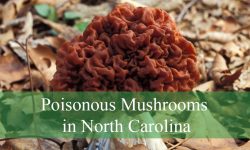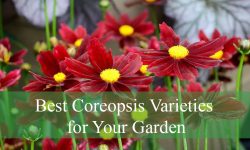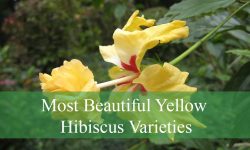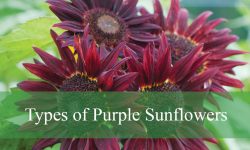Texas is home to an incredible variety of plants, but among its beautiful landscapes lie species that can be dangerously toxic. From wild pastures to backyard gardens, several native and ornamental plants contain poisons capable of harming humans, pets, and livestock.
Knowing how to identify these plants is essential for anyone living or gardening in the Lone Star State. Some species, like poison ivy and bullnettle, can cause painful skin reactions, while others—such as oleander or jimsonweed—pose serious health risks if ingested.
This guide covers 20 of the most poisonous plants in Texas, complete with pictures and key identification tips. Learning to recognize these toxic species will help you stay safe while enjoying the state’s natural beauty and rich biodiversity.
Types of Poisonous Plants Found in Texas
Oleander (Nerium oleander)
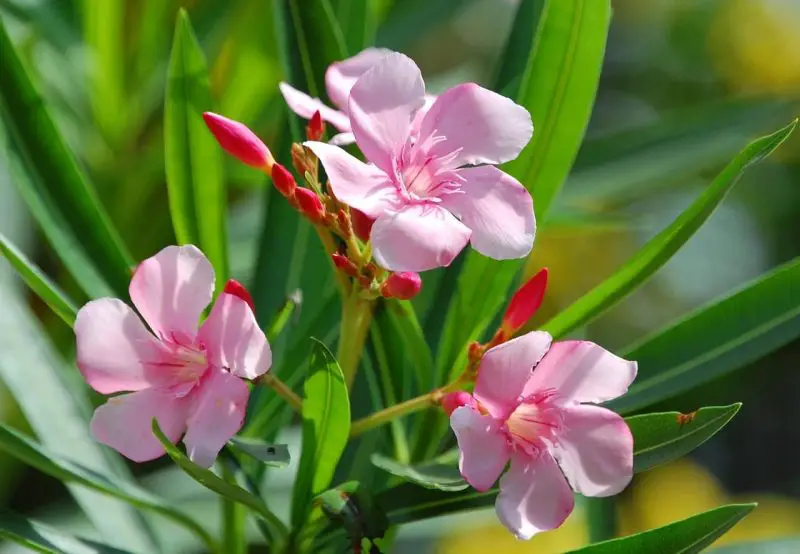
Oleander is one of the most poisonous ornamental shrubs found in Texas, easily recognized by its dense, evergreen foliage and showy clusters of flowers. The flowers come in shades of pink, red, white, or yellow and bloom from spring through early fall, making it a popular landscape plant despite its toxicity. This shrub typically grows between 6 to 12 feet tall and can form thick hedges that are drought-tolerant and heat-resistant, well-suited to the Texas climate.
All parts of the Oleander plant contain potent cardiac glycosides, compounds that affect heart function. Ingesting even a small amount of leaves, flowers, or stems can cause nausea, vomiting, irregular heartbeat, and potentially fatal cardiac arrest in humans, pets, and livestock. The smoke from burning Oleander trimmings is also toxic when inhaled. Because of this, it’s important not to compost clippings or allow grazing animals near the plant.
Oleanders are commonly found in urban landscapes across Central and South Texas, particularly in warm regions such as San Antonio, Austin, and along the Gulf Coast. They thrive in full sun and poor soils but should be handled with extreme caution. Homeowners who plant Oleanders should always wear gloves when pruning and ensure pets and children are kept away from this dangerous yet beautiful shrub.
Poison Ivy (Toxicodendron radicans)
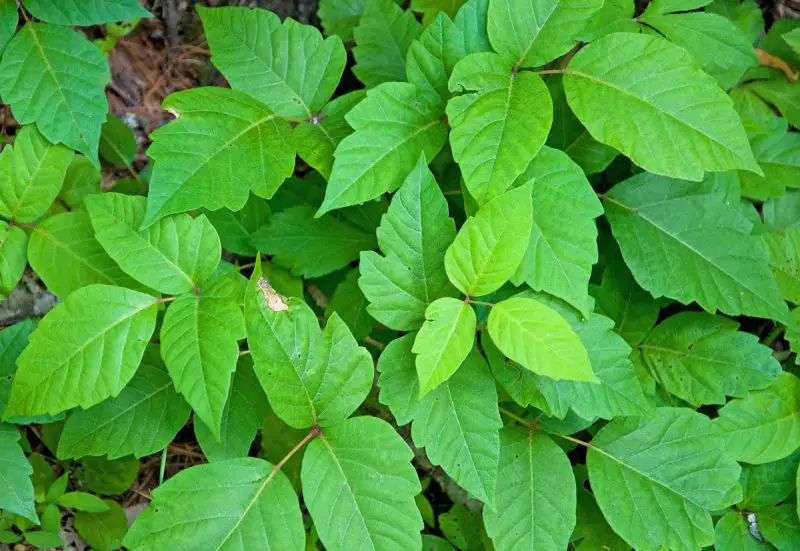
Poison Ivy is one of the most widespread and notorious poisonous plants in Texas, recognized by its compound leaves grouped in threes—hence the saying “Leaves of three, let it be.” The plant varies in form, growing as a groundcover, shrub, or climbing vine that attaches to trees and fences using small rootlets. In spring and summer, it bears small greenish-white flowers, followed by clusters of whitish berries in the fall.
The danger of Poison Ivy comes from urushiol oil, a potent allergen found in all parts of the plant, including leaves, stems, and roots. Contact with even a small amount can cause severe dermatitis, resulting in itchy blisters and rashes. The oil can linger on clothing, tools, and pet fur, spreading the irritation if not washed thoroughly. Burning Poison Ivy releases urushiol into the air, which can cause serious respiratory problems if inhaled.
Poison Ivy grows abundantly throughout Texas—from East Texas woodlands to Central Texas pastures and along riverbanks. It favors areas with partial shade and moist soil, but it’s adaptable enough to survive in many habitats. Gardeners, hikers, and campers should always wear gloves, long sleeves, and pants when in brushy or wooded areas, and wash exposed skin and clothes immediately after contact to avoid painful reactions.
Poison Sumac (Toxicodendron vernix)
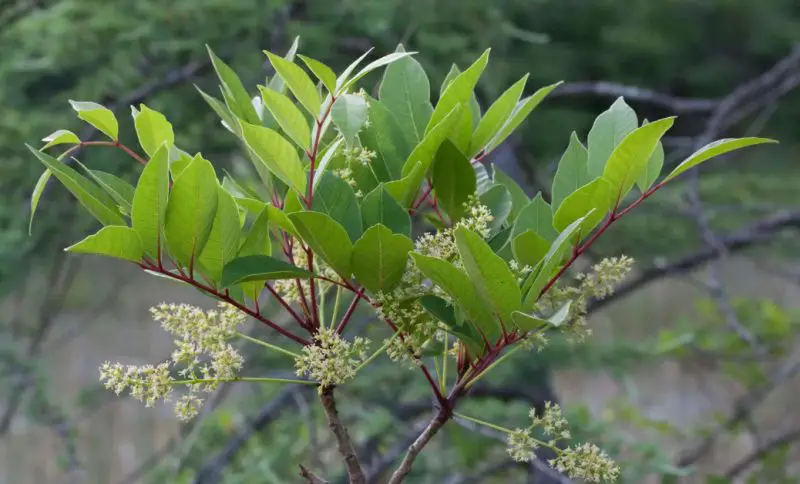
Poison Sumac is less common in Texas than Poison Ivy, but it’s considered even more toxic where it does occur. This woody shrub or small tree can grow 5 to 20 feet tall and is easily recognized by its pinnate leaves, each with 7 to 13 smooth-edged, glossy leaflets that turn bright red in fall. It produces small clusters of greenish-white berries similar to those of Poison Ivy but hangs in loose, drooping formations rather than tight clusters.
Like its relatives, Poison Sumac contains urushiol oil, the same chemical responsible for severe allergic skin reactions. Direct contact with the leaves, bark, or sap can cause painful, itchy rashes and blisters. The urushiol concentration in Poison Sumac is higher than in Poison Ivy or Poison Oak, making even brief exposure dangerous. The smoke from burning branches or leaves can also cause serious lung irritation and inflammation.
In Texas, Poison Sumac is primarily found in the eastern and southeastern parts of the state, especially in wet, swampy areas such as the Big Thicket and along the edges of rivers and bayous. It prefers poorly drained soils and is not usually found in drier central or western regions. Because it thrives in wet habitats, those exploring marshes or floodplains should exercise caution and learn to identify its shiny leaves and red stems before venturing off-trail.
Texas Bullnettle (Cnidoscolus texanus)
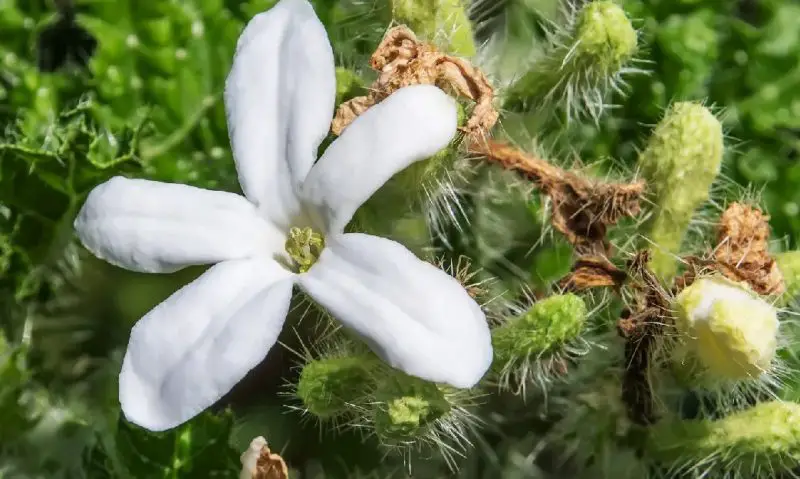
Texas Bullnettle, also known as Mala Mujer or Tread-Softly, is a native perennial herb found widely across Texas, especially in sandy soils, pastures, and roadsides. This upright plant grows 1 to 3 feet tall, with deeply lobed, rough leaves and prickly stems covered in stinging hairs. During spring and summer, it produces clusters of white, five-petaled flowers that contrast beautifully with its spiny appearance. Despite its beauty, it’s a plant best admired from a distance.
The stems, leaves, and seed pods of Texas Bullnettle are covered with fine, hollow hairs that inject a painful, burning irritant when touched. The sting is immediate, causing redness, swelling, and a lingering burning sensation that can last for hours. While the plant’s seeds are edible when roasted, collecting them is risky without protective gloves and clothing. The plant’s sap can also irritate sensitive skin, so contact should be avoided.
This plant is common throughout Central, North, and West Texas, particularly in dry, open habitats and disturbed areas. It plays an ecological role by providing nectar to pollinators like bees and butterflies, but for humans and livestock, it’s a painful nuisance. Ranchers, hikers, and field workers are advised to wear long pants and gloves when navigating areas where Bullnettle grows to prevent painful encounters.
Jimsonweed / Datura (Datura stramonium)
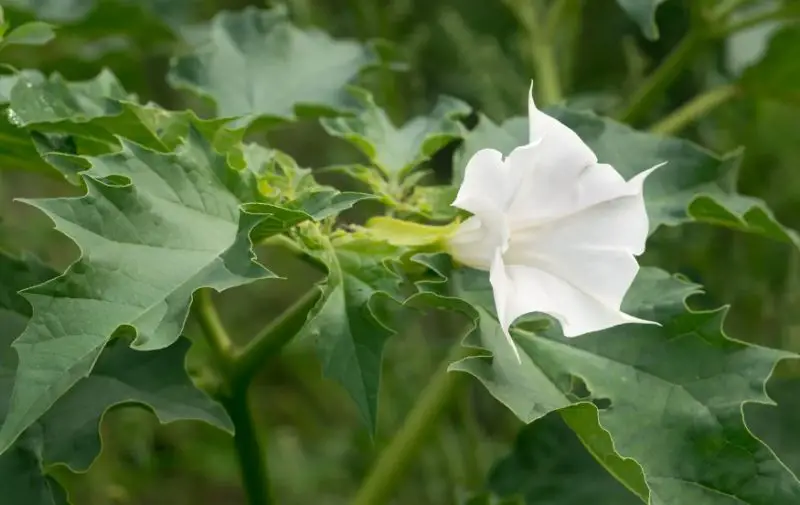
Jimsonweed, also known as Thorn Apple or Devil’s Snare, is a poisonous flowering plant found throughout Texas in disturbed soils, along roadsides, and near cultivated fields. This annual herb grows 2 to 5 feet tall with large, irregularly lobed leaves and striking trumpet-shaped white or lavender flowers that bloom at night. The spiny seed pods resemble small green balls covered with sharp thorns, giving rise to the name “Thorn Apple.”
The plant contains potent tropane alkaloids—atropine, scopolamine, and hyoscyamine—which act on the nervous system and can cause hallucinations, rapid heartbeat, confusion, and in severe cases, respiratory failure or death. Both the seeds and leaves are highly toxic, and even small amounts can lead to dangerous poisoning in humans and animals. Historically, Jimsonweed has been associated with accidental poisonings and misuse due to its hallucinogenic effects.
In Texas, Jimsonweed thrives in hot, dry regions across the state, particularly in Central and South Texas. It prefers sunny areas with disturbed or sandy soils, often appearing after heavy rains. While it’s sometimes mistaken for harmless wildflowers, Jimsonweed’s distinctive thorny seed capsules and unpleasant odor make it identifiable. Avoid handling or ingesting any part of the plant, and remove it carefully using gloves and protective gear if it grows near homes or livestock areas.
Castor Bean (Ricinus communis)
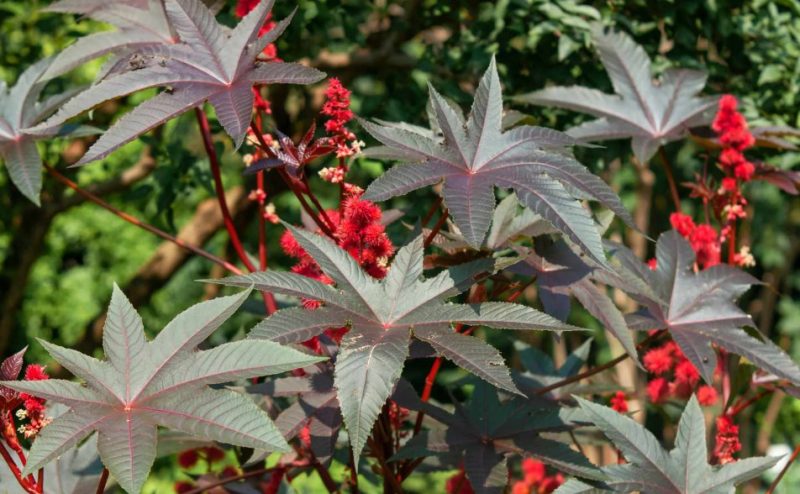
The Castor Bean plant is a striking ornamental species often seen in Texas gardens due to its bold, tropical appearance. It grows as a large annual or short-lived perennial, reaching heights of 6 to 10 feet or more. The plant features large, star-shaped leaves with a glossy, palmate structure, often tinged with deep red or bronze. Its spiky seed pods contain the shiny, mottled seeds that resemble beans—beautiful but deadly.
The danger of Castor Bean lies in its seeds, which contain ricin, one of the most toxic naturally occurring substances known. Ingesting just one or two seeds can cause severe abdominal pain, vomiting, diarrhea, dehydration, and organ failure. Ricin works by preventing cells from producing essential proteins, leading to systemic poisoning. There is no antidote, and ingestion can be fatal to humans and animals. Even handling broken seeds can pose a risk if hands are not washed afterward.
In Texas, Castor Bean plants grow in both cultivated gardens and wild areas, especially in the southern and central regions where the climate is warm. The plant thrives in full sun and well-drained soils, often appearing in vacant lots, along roadsides, or near streams. While its dramatic foliage adds exotic flair, homeowners are strongly advised to keep it away from children, pets, and livestock, and to avoid planting it in residential landscapes where accidental exposure could occur.
Pokeweed / Pokeberry (Phytolacca americana)
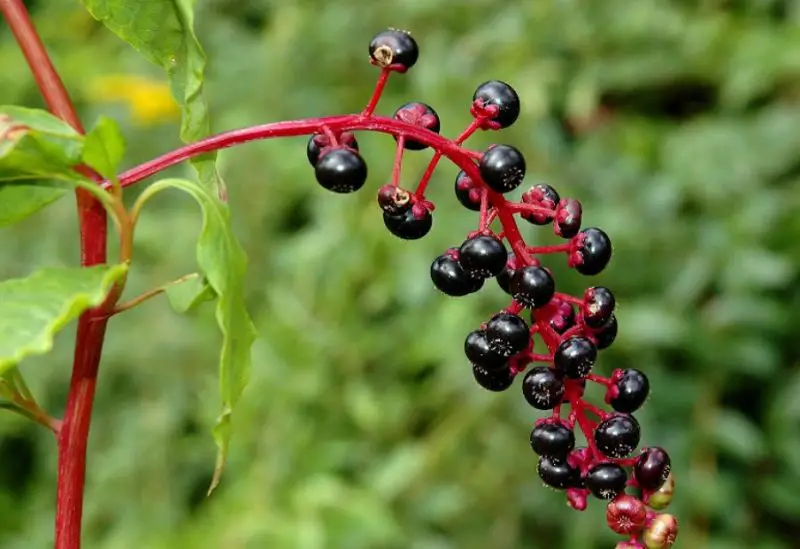
Pokeweed is a native Texas plant recognized by its tall, reddish-purple stems and large, glossy green leaves. It grows 4 to 10 feet tall, producing long clusters of small white flowers that develop into dark purple, berry-like fruits. The berries are visually attractive, and their deep color was historically used for dye, but despite their beauty, all parts of this plant—especially the roots and berries—are toxic to humans and animals.
The toxic components of Pokeweed include saponins and alkaloids, which can cause nausea, vomiting, diarrhea, difficulty breathing, and low blood pressure when ingested. Children are at particular risk because the shiny purple berries look appealing and sweet. While some traditional food practices involve boiling the young shoots to remove toxins, improper preparation can still result in poisoning. Livestock and pets may also suffer illness if they consume the leaves or berries.
Pokeweed grows widely throughout Texas, thriving in disturbed soils, pastures, woodland edges, and fence lines. It prefers sunny to partially shaded areas with moist soil. While it plays an ecological role by providing berries for birds, which are unaffected by the toxins, humans should handle it with care. Gloves are recommended when pulling or cutting Pokeweed, and any plant debris should be discarded safely, away from areas where children or pets play.
Lantana (Lantana camara)
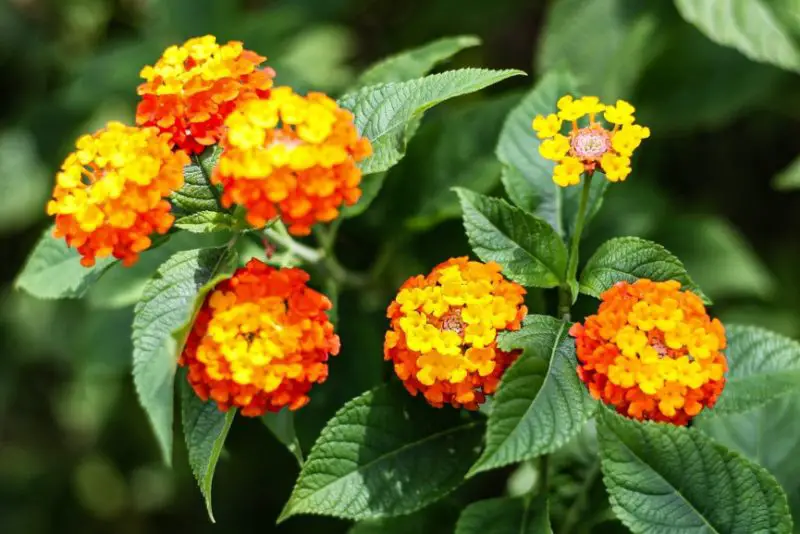
Lantana is a common ornamental shrub in Texas known for its vibrant clusters of flowers that can range in color from yellow and orange to pink, red, and purple. The plant grows 2 to 6 feet tall and is a favorite among gardeners for its drought tolerance and ability to attract butterflies. Its rough, textured leaves and strong, citrus-like scent make it easy to identify, and it blooms profusely from spring through fall in the Texas heat.
Despite its beauty, Lantana contains toxic compounds called triterpenoids, which can cause gastrointestinal distress, weakness, and liver damage when ingested. The green, unripe berries are especially poisonous to children, pets, and livestock. Symptoms of poisoning include vomiting, loss of appetite, and lethargy. In severe cases, especially in grazing animals like cattle or horses, it can cause photosensitivity and even death. Contact with the foliage can also cause mild skin irritation in sensitive individuals.
Lantana grows abundantly across Texas, from coastal regions to dry inland areas, and can become invasive in some environments. It prefers full sun and well-drained soils, thriving in both gardens and wild areas. Homeowners should be cautious when planting Lantana in yards with pets or small children and consider using non-toxic native alternatives. If grown ornamentally, regular pruning and careful disposal of clippings can help control its spread and reduce accidental exposure.
Mountain Laurel (Sophora secundiflora)
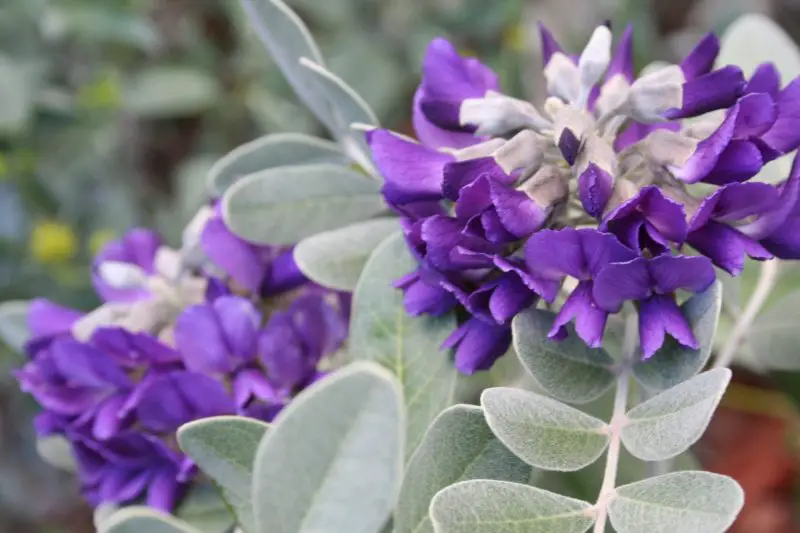
Texas Mountain Laurel, an iconic native shrub or small tree, is prized for its glossy evergreen leaves and fragrant, purple-blue flower clusters that resemble wisteria blooms. These stunning flowers appear in early spring, filling the air with a sweet, grape-like scent. The plant typically grows 6 to 15 feet tall, with smooth gray bark and dense foliage that make it a popular ornamental choice across the state.
However, all parts of the Mountain Laurel—especially its shiny red seeds—are poisonous. The seeds contain cytisine-like alkaloids, compounds similar to nicotine, which affect the nervous system. Chewing or swallowing even a single seed can cause nausea, vomiting, confusion, convulsions, and in rare cases, death. Despite their toxicity, the bright seeds are often used for crafts or jewelry, which poses an additional risk if children mistake them for candy.
Mountain Laurel is native to central and western Texas, thriving in rocky limestone soils and dry, sunny environments. It’s a common sight in the Texas Hill Country, often used in landscaping for its beauty and drought resistance. Gardeners should take care to prevent accidental ingestion by pets or children and avoid handling the seeds unnecessarily. Though it’s one of Texas’s most beautiful native plants, it’s also among its most deceptively toxic.
Foxglove (Digitalis spp.)
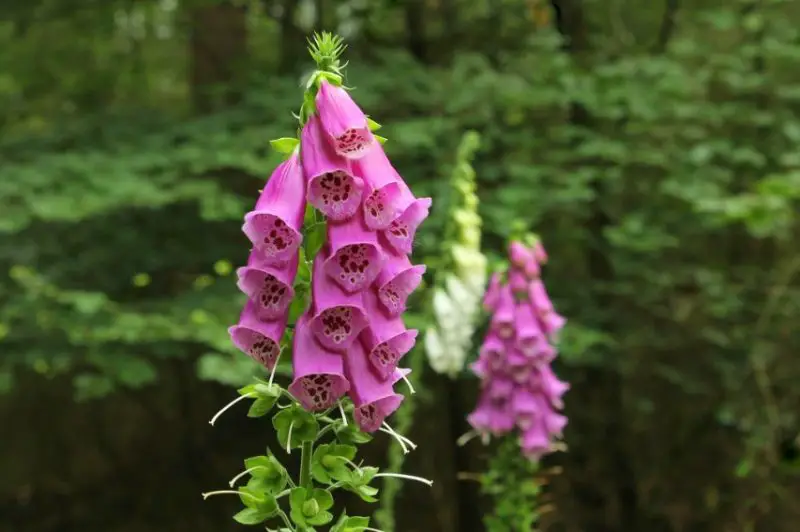
Foxglove is an elegant, towering plant admired for its tall spikes of tubular flowers that come in shades of purple, pink, white, and yellow. Each flower is beautifully speckled inside, attracting hummingbirds and pollinators. In Texas, Foxglove is often grown as a garden ornamental, reaching heights of 2 to 5 feet. The plant prefers cool seasons, blooming from late spring into early summer in areas with partial shade and well-drained soil.
All parts of the Foxglove plant contain digitalis compounds, which directly affect the heart. Ingestion of even small amounts can lead to symptoms such as nausea, vomiting, dizziness, irregular heartbeat, and cardiac arrest. These compounds, once used in medicine under strict control, make accidental ingestion especially dangerous. Pets and livestock are equally vulnerable, and children may be tempted by the plant’s colorful blooms if grown in accessible areas.
Foxglove can be found in Texas gardens, particularly in cooler regions or shaded landscapes where it’s cultivated as a biennial or annual. It’s rarely found growing wild but thrives in well-tended ornamental beds. Gardeners who handle Foxglove should wear gloves and wash hands afterward, as the plant’s sap can be absorbed through the skin. Its striking beauty makes it a favorite for ornamental planting, but its toxic nature requires caution and respect in every setting.
Rhododendron / Azalea

Rhododendrons and Azaleas are prized ornamental shrubs found across Texas gardens for their vibrant blooms and glossy green leaves. Azaleas, a subgroup of Rhododendrons, typically grow 3 to 6 feet tall, producing trumpet-shaped flowers in shades of pink, white, red, purple, and orange during spring. The plants thrive in acidic, well-drained soils and prefer partial shade, making them popular in landscaped yards and woodland gardens.
Despite their beauty, all parts of Rhododendron and Azalea plants contain grayanotoxins, a group of neurotoxic compounds that disrupt the normal function of cells. Ingestion of leaves, nectar, or flowers can cause severe poisoning in humans and animals. Symptoms include vomiting, drooling, weakness, dizziness, low blood pressure, and irregular heartbeat. In large amounts, these toxins can lead to cardiac arrest. Even honey made from Azalea nectar, known as “mad honey,” can cause toxic reactions.
In Texas, these plants are commonly grown in the eastern and central regions, where soils are more acidic and rainfall is higher. They are less common in the arid west but can still be found in shaded, irrigated landscapes. While admired for their spectacular spring displays, homeowners should plant Rhododendrons and Azaleas with caution, ensuring pets and livestock do not browse the leaves or flowers. Gloves are also recommended when pruning or handling clippings.
Rosary Pea (Abrus precatorius)
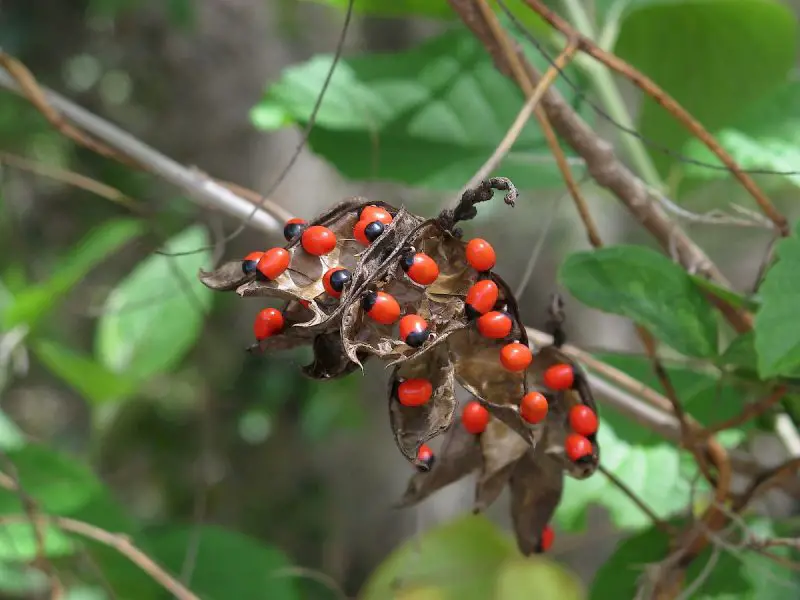
Rosary Pea, also called Jequirity Bean or Crab’s Eye, is a twining vine recognized for its striking red seeds with a black spot—resembling tiny ladybugs. Native to tropical regions but naturalized in parts of Texas, the plant produces delicate pink to lavender flowers and slender pods that split open to reveal the glossy seeds. Its leaves are small, paired, and feathery, giving the vine a graceful appearance as it climbs fences and shrubs.
While the seeds are often used in jewelry and crafts, they contain abrin, one of the most potent plant toxins known—far more toxic than ricin. The hard seed coat prevents poisoning if swallowed whole, but when chewed, abrin is released and rapidly absorbed into the body. Ingestion causes nausea, vomiting, diarrhea, dehydration, and organ failure, often leading to death. Even a single crushed seed can be fatal to an adult human or animal.
In Texas, Rosary Pea is occasionally found in southern and coastal regions, particularly in disturbed areas, old homesteads, and along roadsides. It thrives in warm, subtropical climates and can become invasive. Because of its extreme toxicity, planting or handling Rosary Pea is strongly discouraged. People who collect or use the seeds in crafts should take great care not to pierce or crush them, and children should never be allowed to handle them.
Poison Hemlock (Conium maculatum)
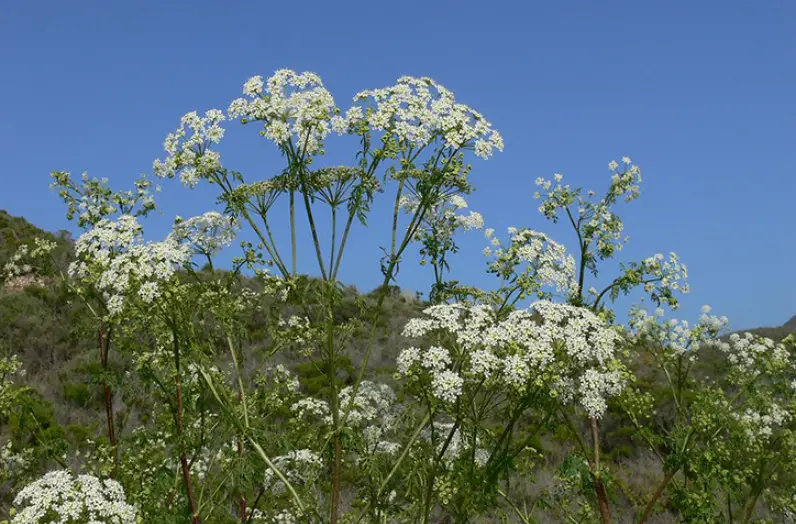
Poison Hemlock is one of the most dangerous wild plants in Texas, infamous for its role in historical poisonings. This tall biennial plant can reach 6 to 10 feet in height and resembles Queen Anne’s Lace or wild carrot, with clusters of small white flowers arranged in umbrella-like formations. Its stems are smooth, hollow, and marked with distinctive purple blotches—a key identification feature. The leaves are finely divided and fern-like, emitting a foul, mousy odor when crushed.
The plant contains several highly toxic piperidine alkaloids, including coniine and γ-coniceine, which interfere with the nervous system and cause respiratory paralysis. Ingestion of even small amounts can result in nausea, tremors, muscle weakness, and eventually respiratory failure. All parts of the plant are poisonous—especially the roots—and toxicity remains after the plant has dried. Livestock and humans have both been fatally poisoned after mistaking it for edible species.
In Texas, Poison Hemlock is commonly found in disturbed soils, along roadsides, streams, irrigation ditches, and pastures—especially in the central and northern regions. It thrives in moist environments and spreads rapidly through seed. Anyone identifying or removing this plant should wear gloves and long sleeves, as the sap can cause skin irritation. The safest approach is to avoid handling unknown umbel-shaped plants and to educate others about its deadly look-alike nature.
Giant Hogweed / Cow Parsnip Look-Alikes
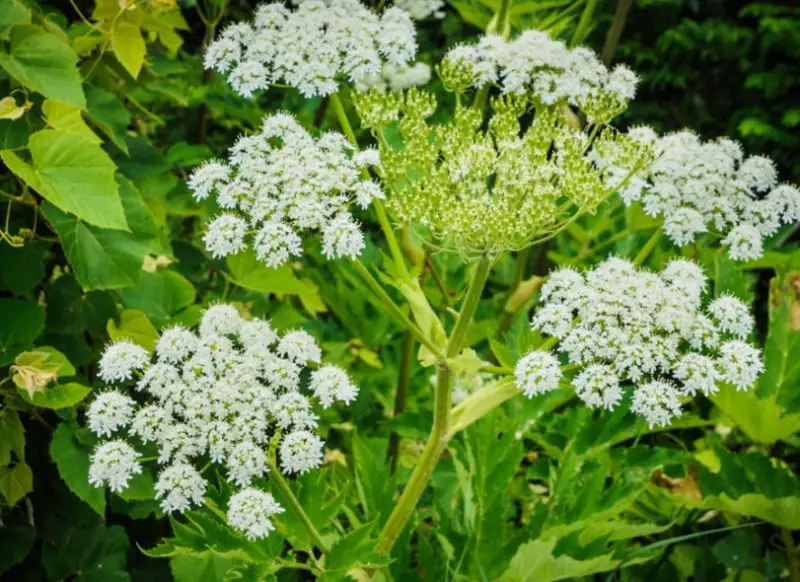
Large umbel-forming plants like Giant Hogweed (Heracleum mantegazzianum) and its relatives—such as Cow Parsnip and other members of the carrot family—can pose serious health risks to people who handle them. While true Giant Hogweed is rare in Texas, several look-alikes, including Cow Parsnip and wild parsnip, are present in the state. These tall plants can reach 6 to 10 feet in height, with broad, lobed leaves and clusters of white flowers in large, umbrella-like formations.
The main danger comes from phototoxic compounds in the sap known as furanocoumarins. When the sap contacts skin and is then exposed to sunlight, it causes severe burns, blistering, and long-lasting scars—a condition known as phytophotodermatitis. Eye exposure can lead to temporary or permanent blindness. Even brushing against the plant can trigger reactions, especially in sunny, humid conditions.
These plants are often found in moist habitats across East and Central Texas, such as streambanks, ditches, and woodland edges. Because of their similar appearance, many people mistake them for harmless wildflowers or edible relatives like Queen Anne’s Lace. Experts strongly advise not to touch or collect any unknown umbel-shaped plant. If contact occurs, wash the area immediately with soap and water and avoid sunlight until medical help is received.
Perilla Mint / Shiso (Perilla frutescens)
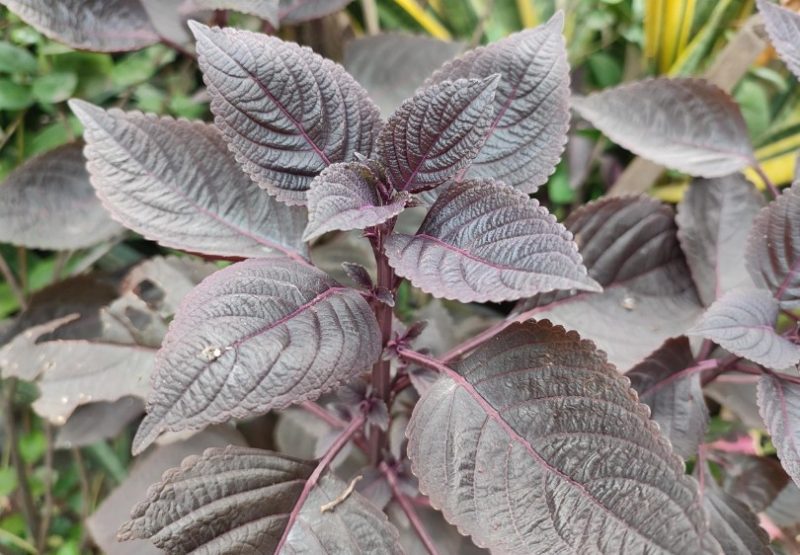
Perilla Mint, also known as Shiso, is a fragrant herb with square stems, broad oval leaves, and serrated edges. The leaves are often green or purplish-bronze and emit a distinctive minty aroma when crushed. While used in Asian cuisine under controlled conditions, wild Perilla Mint has become an invasive weed in Texas, often growing 1 to 3 feet tall in shaded pastures, woodlands, and along roadsides.
This plant poses a significant threat to livestock, particularly cattle, goats, and horses. It contains perilla ketone, a compound that damages lung tissue and can cause severe respiratory distress known as “Perilla Mint toxicosis.” Affected animals may exhibit labored breathing, frothing, or collapse after grazing on the plant. Even dried plant material retains its toxicity, making hay contaminated with Perilla Mint dangerous. Humans may also experience mild nausea or irritation if the raw plant is consumed in large quantities.
Perilla Mint is listed among Texas’s toxic pasture plants and is especially common in East and Central Texas, where it thrives in moist, shaded environments. Farmers and landowners should monitor grazing areas carefully, remove any infestations before flowering, and avoid feeding contaminated hay. While it can be cultivated safely as an herb in home gardens, wild Perilla Mint should be regarded as a hazardous weed rather than a useful plant.
Kalanchoe, Dieffenbachia (Dumb Cane), and Elephant Ear
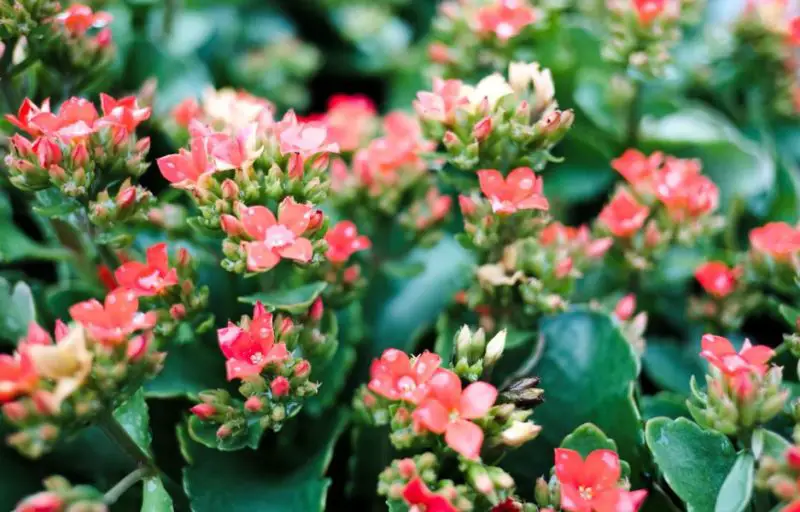
Kalanchoe, Dieffenbachia, and Elephant Ear are common ornamental houseplants found in many Texas homes and offices, appreciated for their striking foliage and easy maintenance. Kalanchoe produces clusters of bright, star-shaped flowers in red, orange, pink, or yellow atop succulent leaves, thriving in bright indoor light. Dieffenbachia, often called Dumb Cane, features large, variegated green-and-white leaves and prefers indirect light and high humidity. Elephant Ear (Alocasia, Colocasia, or Caladium) varieties are grown for their broad, heart-shaped leaves that add a tropical feel to any space.
Despite their popularity, all three plants contain toxic compounds that can irritate the mouth, throat, and digestive tract. Kalanchoe contains bufadienolides, cardiac glycosides that can affect heart rhythm when ingested in large amounts—especially dangerous to pets. Dieffenbachia and Elephant Ear both contain calcium oxalate crystals, which cause intense burning, swelling, and drooling if chewed. Contact with the sap may lead to skin irritation, and ingestion can cause swelling of the tongue and throat, making breathing difficult in severe cases.
In Texas, these plants are primarily cultivated as indoor or patio ornamentals. They thrive in warm temperatures and filtered light, which suits the local climate well. Homeowners should keep these plants out of reach of children and pets and wear gloves when pruning or repotting to avoid skin irritation. For pet owners, it’s best to substitute these plants with non-toxic alternatives such as spider plants or Boston ferns to maintain both beauty and safety in the home.
Daffodil / Narcissus Bulbs
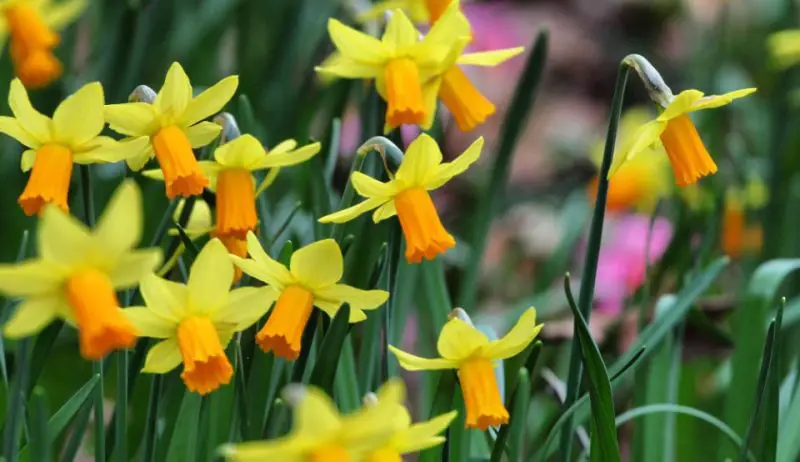
Daffodils and other Narcissus species are iconic spring flowers that add bright yellow and white blooms to gardens across Texas. They grow from bulbs planted in fall and bloom in late winter or early spring, signaling the end of cold weather. Each flower features six petal-like tepals surrounding a trumpet-shaped corona, and the plant’s upright, strap-like leaves emerge before the flowers fade. Daffodils thrive in well-drained soil and full sun to partial shade, making them a Texas garden favorite.
However, the bulbs of Daffodils are toxic if ingested. They contain alkaloids such as lycorine, which can cause nausea, vomiting, abdominal pain, and diarrhea. Ingesting large amounts may lead to more severe symptoms like low blood pressure or irregular heartbeat. The toxicity is concentrated in the bulbs but is also present in the leaves and flowers to a lesser degree. Handling large quantities of bulbs may also cause skin irritation known as “daffodil itch.”
In Texas, Daffodils are commonly grown in gardens and naturalized along roadsides, especially in northern and central regions with cooler winters. Gardeners should store bulbs safely away from children and pets, as they can be mistaken for onions or garlic. When planting or dividing bulbs, wearing gloves helps prevent skin irritation. Although these flowers are beautiful and easy to grow, caution ensures they remain a safe part of the landscape.
Rhubarb Leaves
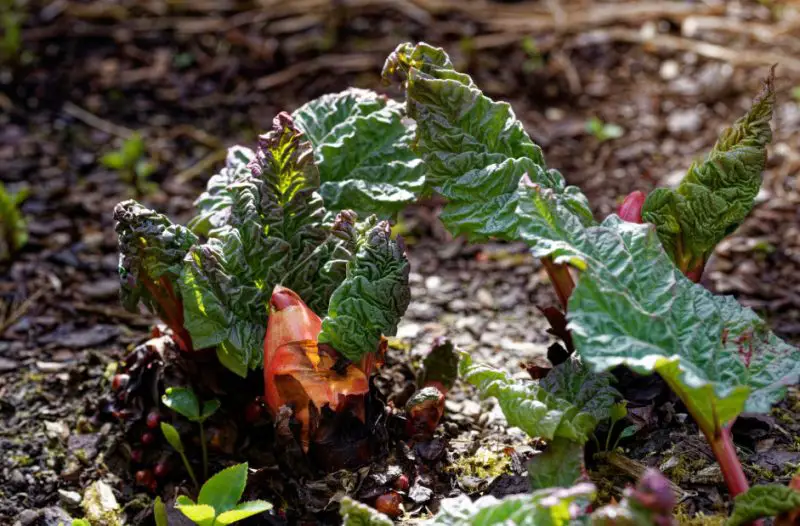
Rhubarb (Rheum rhabarbarum) is a perennial plant grown for its edible stalks, which are used in pies, jams, and sauces. The plant is easily recognized by its large, triangular green leaves and thick red or pink stalks. In Texas gardens, Rhubarb grows best in cooler seasons, typically in northern areas or during early spring and fall, as it struggles in extreme summer heat.
While the stalks are safe to eat once cooked, the leaves are toxic due to their high concentration of oxalic acid and other soluble oxalates. Consuming large quantities of leaves can cause nausea, vomiting, difficulty breathing, and, in extreme cases, kidney damage. Even small amounts can irritate the mouth and stomach. Fortunately, the bitter taste of the leaves discourages most accidental ingestion, but pets and livestock may still be at risk if given access to garden waste.
Rhubarb should always be harvested carefully, separating leaves from stalks and discarding them immediately. Composting leaves is generally safe if managed properly, but they should not be used as animal feed. In Texas gardens, Rhubarb is best treated as a seasonal vegetable crop, grown in shaded or cooler locations and always handled with awareness of the toxic potential of its leafy parts.
Nightshade Family Members
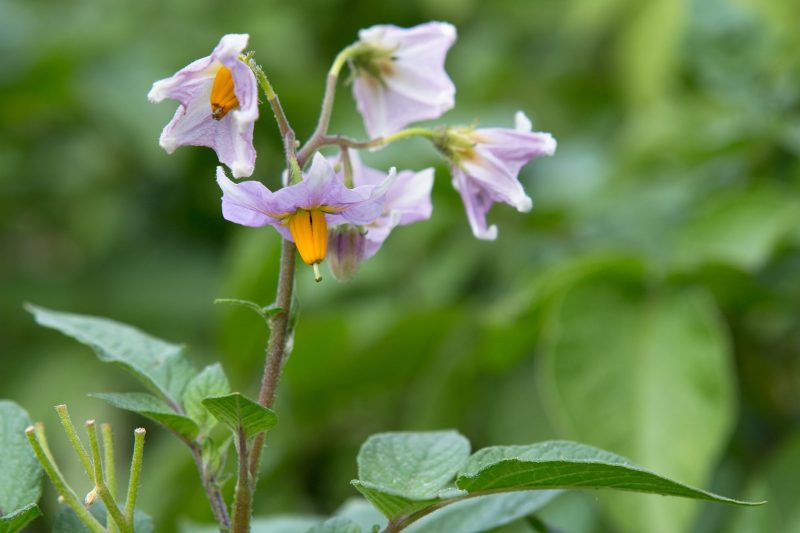
Members of the nightshade family (Solanaceae) include many familiar plants—both edible and toxic. While tomatoes, peppers, and eggplants are safe when properly prepared, their wild relatives such as Bittersweet Nightshade (Solanum dulcamara) and Deadly Nightshade (Atropa belladonna) are highly poisonous. These plants typically have slender stems, oval leaves, and clusters of star-shaped purple or white flowers that develop into bright red or black berries. Their beauty often hides the danger within.
The toxic components are solanine and atropine-like alkaloids, which affect the nervous system and digestive tract. Ingesting the berries or foliage can lead to symptoms such as nausea, vomiting, abdominal cramps, confusion, dilated pupils, and in severe cases, respiratory paralysis or death. Even livestock can be poisoned by grazing on nightshade plants. Handling the sap or crushed foliage may also cause mild skin irritation in sensitive individuals.
In Texas, wild nightshades can be found growing along fencerows, woodlands, and roadsides, particularly in moist soils. Their berries are especially tempting to children and birds, though birds are generally unaffected by the toxins. Gardeners should remove any wild nightshade plants from residential areas and teach children never to eat berries found in the wild. Identifying and managing these look-alikes is vital to preventing accidental poisoning.
Certain Decorative Shrubs and Trees
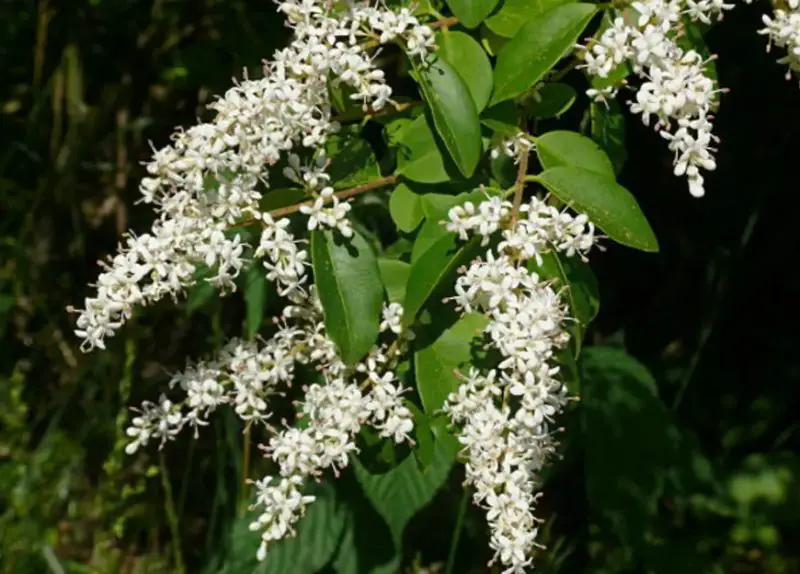
Many decorative shrubs and trees used in Texas landscaping contain toxic parts that can harm people and animals. Species such as Cotoneaster, Privet (Ligustrum spp.), and Oleander relatives are popular for their dense foliage, colorful berries, and ability to thrive in Texas’s varied climate. Cotoneaster and Privet produce clusters of red or black berries that remain through winter, attracting birds and adding visual appeal to gardens and public spaces.
However, these ornamental plants harbor toxins that can cause gastrointestinal distress and, in some cases, serious illness. Cotoneaster berries contain cyanogenic glycosides, which release cyanide when digested, leading to symptoms such as nausea, headache, and difficulty breathing. Privet berries and leaves contain compounds that cause vomiting, abdominal pain, and weakness. Oleander relatives, including species in the Apocynaceae family, contain cardiac glycosides that can affect heart rhythm and are potentially fatal if ingested.
These shrubs and trees are found throughout Texas in both urban and rural landscapes, often used for hedges, screens, and decorative borders. While they are valuable for their beauty and low maintenance, caution should be taken when planting them in family yards, schools, or pet areas. Gardeners should research plant toxicity before choosing ornamental species and ensure that berries or clippings are disposed of safely to prevent accidental ingestion by children or animals.
Tips to Stay Safe from Poisonous Plants in Texas
Learn to Identify Common Toxic Species
Familiarize yourself with the appearance of plants such as poison ivy, oleander, and jimsonweed. Take note of leaf shape, growth pattern, and habitat. Many toxic plants have distinct features—like the three-leaf clusters of poison ivy or the bright red seeds of Texas mountain laurel.
Wear Protective Clothing When Outdoors
When hiking, gardening, or working in the field, always wear long sleeves, gloves, and pants. This helps prevent skin contact with irritants like urushiol oil from poison ivy or the stinging hairs of bullnettle. After outdoor activities, wash clothes and tools thoroughly to remove any plant residues.
Keep Pets and Livestock Away from Dangerous Plants
Many ornamental plants such as lantana, oleander, and sago palm are toxic to animals. Ensure pets do not chew on landscaping plants or graze near areas where toxic weeds grow. Check your pasture for invasive species like perilla mint that can harm livestock.
Dispose of Toxic Plants Safely
When removing poisonous plants, never burn them—smoke can irritate lungs and cause serious reactions. Instead, wear gloves, pull them out by the root, and place them in sealed plastic bags for disposal. Always wash your hands afterward, even if gloves were used.
Educate Your Family and Community
Teach children not to touch or eat unknown plants or berries. Share information about local poisonous plants with neighbors and gardening clubs. Awareness and prevention are the best tools to avoid plant-related poisoning incidents in Texas.
FAQs about Poisonous Plants in Texas
What is the most poisonous plant in Texas?
Oleander is often considered the most poisonous plant in Texas. All parts of the plant—especially leaves and flowers—contain cardiac glycosides that can cause heart failure if ingested. Even small amounts can be fatal to humans and animals.
Can touching a poisonous plant make you sick?
Yes. Plants like poison ivy, poison oak, and bullnettle can cause severe skin irritation, blisters, and itching just from contact. The oil or hairs that cause reactions can stick to clothing, pets, and tools, leading to indirect exposure.
What should I do if I come into contact with a toxic plant?
Immediately wash the affected area with soap and cool water. Avoid scratching the skin and apply calamine lotion or an antihistamine cream to reduce itching. If you develop a rash or difficulty breathing, seek medical attention right away.
Are there poisonous plants dangerous to pets in Texas?
Yes. Lantana, oleander, sago palm, and azalea are among the most toxic to dogs and cats. Symptoms may include vomiting, drooling, weakness, or heart irregularities. Contact your veterinarian or the ASPCA Animal Poison Control Center if ingestion occurs.
How can I safely identify poisonous plants around my home?
Use a Texas-native plant field guide or apps like PlantSnap or iNaturalist for image-based identification. You can also contact your local Texas A&M AgriLife Extension office—they provide free identification services and safety recommendations for your area.
Are all wild plants in Texas dangerous?
No, most wild plants are harmless, but several can cause skin irritation or poisoning if eaten. When in doubt, never taste or handle unknown plants without identification. Remember the golden rule: “Leaves of three, let it be.”
Is it safe to burn brush containing poison ivy or oleander?
No. Burning these plants releases toxic particles and oils into the air, which can cause serious lung irritation or poisoning. Always bag and dispose of them properly instead of burning.
Where can I report or learn more about toxic plants in Texas?
You can contact the Texas Poison Center Network (1-800-222-1222) for human exposure emergencies or visit the Texas A&M AgriLife Extension for detailed guides on poisonous plants affecting people, pets, and livestock.

